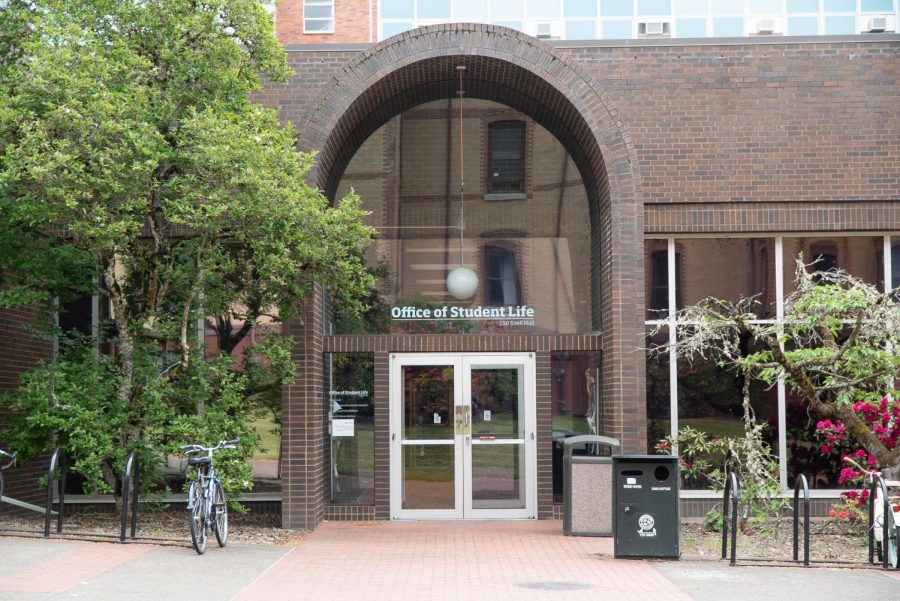Sexual assault alerts, education reaches students via timely warnings
July 16, 2018
There were 14 reported sexual assaults on the Oregon State University Corvallis campus in 2016, according to the 2017 Annual Security and Fire Safety Report. A study by the Association of American Universities estimates sexual assault reporting rates between 5 and 28 percent, depending on the specific type of behavior, while the Rape, Abuse & Incest National Network corroborates that 20 percent of female student ages 18-24 report their sexual assault to law enforcement.
At OSU, students’ knowledge of potential threats to their safety on campus is managed largely by a group of university officials, who make case-by-case decisions on whether to release information to the student body and how much information to release. This group includes the chief of public safety, the vice president of finance and administration, the vice president of university relations and marketing, the vice provost of student affairs, the dean of student life, and other OSU administrators, as well as Oregon State Police and OSU public safety officials.
The group considers factors including legality, the desire for campus safety, as well as available information every time a threat is perceived or reported to our department as to whether a timely warning or emergency notification is sent to our community, according to Suzy Tannenbaum, director of the Department of Public Safety.
OSU has procedures in place for handling sexual assault reports and deciding whether or not to alert the student body via a timely warning or other method of communication, says Tannenbaum. This procedure remains consistent for both acquaintance assaults, where the survivor knows the attacker, and stranger assaults.
“When the university’s Public Safety dispatch center is notified of a reported sexual assault or other criminal incident that would be considered a Clery crime, regardless of time of day, as the Chief of Public Safety, I will immediately convene by phone a standing 24/7 committee of university officials and Oregon State Police assigned to OSU,” Tannenbaum said via email.
A Clery crime is one that falls under the Clery Act, which states that federally-funded universities must collect and publish statistics on serious or continuing threats that occur on or near the campus. According to Steve Clark, the vice president of university relations and marketing, these threats include but are not limited to: sexual assault, homicide, hate crimes, robbery and a person with the intent to use a weapon.
According to Clark, once the committee is summoned by Tannenbaum, they balance multiple factors to decide whether to release a statement.
“The decision to send a timely warning or emergency notification is made by the chief of public safety and the vice presidents based upon the incident information available at the time; OSU’s strong interest in public safety; and the legal requirements outlined within the Clery Act,” Clark said via email.
According to Tannenbaum, there are post-report protection plans available for survivors of sexual assault who no longer feel safe on campus, provided by DPS. OSU aims to create an environment where survivors feel safe coming forward with reports of assaults, as well as navigating campus afterward.
“The Department of Public Safety does provide safety escorts, if requested for those that feel unsafe,” Tannenbaum said via email. “We also work with survivors to implement individualized safety plans to assist the survivor to feel safer on campus.”
Besides safety plans for aiding survivors, OSU aims to act preemptively on stopping sexual assaults.
According to Judy Neighbours, director of Survivor Advocacy and Resource Center, the university is hoping to implement more trainings for students on awareness and victim blaming, specifically within the online Haven module that newly enrolled students are required to complete before beginning their OSU classes.
“We intend to include more training on the reduction of victim blaming, which I believe will contribute to fewer assaults as that would reduce attitudes that can contribute to violent behaviors,” Neighbours said via email.
Despite efforts to provide awareness via programs like Haven, many myths surrounding sexual assault are still prevalent, Neighbours said. She believes addressing misconceptions and misinformation will create a safer environment for all students.
“I think any time we are willing to have honest conversations about sexual violence and gender based violence we create an environment that will make it safer for survivors to come forward and share their story,” Neighbours said via email. “By taking the taboo away of talking about gender-based violence, we are providing an environment that allows survivors to know that their voice is important and that they will not be blamed or disbelieved.”
Neighbours says that SARC is committed to providing information on sexual assaults and sexual violence to help reduce the frequency of these crimes, while dispelling recurring myths surrounding the issue.
“All of the campus-based training provided by either the Survivor Advocacy and Resource Center and the Student Health Services Violence Prevention team identify and challenge the myths associated with gender based violence, including the myth of stranger rape,” Neighbours said via email. “We inform students and staff of the prevalence of the survivor knowing the perpetrator, which happens in 85-90 percent of all cases; the prevalence of alcohol which increases the vulnerability of folks, and the understanding that the cause of rape is never the survivor and always the person willing to engage in such hurtful and injurious behavior.”











































































































